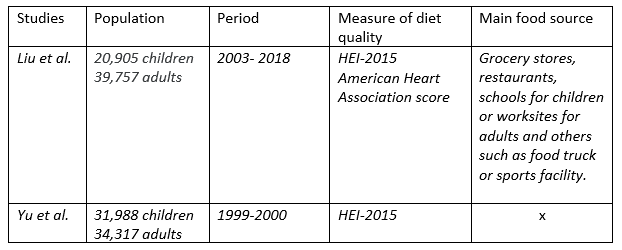Evolution of the American diet quality: better and worse depending on age and food sources

Poor diet quality is a main public health concerned in developed nations, becoming the third leading cause of death and disability-adjusted life-year loss in the US (Mokdad, 2018).
Trend food through the National Health and Nutrition Examination Survey (NHANES) cohort in US
Two studies have provided an update on recent changes in the American diet quality. The first investigation conducted by Liu et al. examined the trends in the quality of diet consumed from major food sources in the United States. Trends in diet quality were investigated both overall and by population sub-group (e.g. sub-groups by age or household income). The second study by Yu et al. was started in 1999-2000 and compare trends changes between US children and adults (Table 1).

Improvement of diet quality occurred in schools with an increase of whole grains and fruit intake
Between 2003-2004 and 2017-2018, the estimated proportion of children with poor diet quality from schools decreased by more than half, from 55.6% to 24.4%(P < .001 for trend). Among food and nutrient components, improvement was attributable to increased consumption of whole grains and fruit, and reduced intake of saturated fat and? sugar-sweetened beverages.
The improvement occurred in all subgroups, mainly after 2010 probably due to the positive impact of Healthy, Hunger-Free Kids Act of 2010 supported by former first lady Michelle Obama. In contrast, disparities were observed in diet quality of foods from grocery stores.
The proportion of children consuming low-nutrient food was stable in low-income households (from 52.7 to 49.7%) but decreased in high-income households (from 51.0 to 37.4%, P = 0.003). From each food source, children had worse overall quality than adults, except from schools. In adults, modest improvements were identified in diet quality for foods consumed from grocery stores (35.8 to 38.3%) or restaurants (28.5 to 29%), and stable or worsening diet quality for foods consumed from other sources.
The findings of this study suggest that foods consumed at schools provided the best mean quality of major US sources but also suggest that the retail grocery, providing approximately two-thirds of calories, remains a key opportunity for improving diet quality.
A diet quality worse in children than in adults during 1999-2018 in the US
In accordance with the study from Liu, these results underline a worse diet quality of children than that of adults. Their findings showed that between 1999-2000 and 2017-2018, overall HEI-2015 score of children increased from 48.73 to 51.59 (P < 0.001). For adults, HEI-2015 score increased from 53.1 to 53.18 (P < 0.001) in the same period. Globally, diet quality of children was more variable than that of adults. From 1999 to 2018, whole grains and added sugars were components changing stably in children in a significant upward trend whereas total vegetables and saturated fats had a significant downward trend (P <0.05 for annual percent change). In comparison, greens and beans, whole grains, seafood and plant proteins, fatty acids increased significantly in adults’ diet whereas vegetables and sodium decreased significantly ( P < 0.05 for annual percent change).
Public health action needed to improve diet quality
In conclusion, both publications emphasize the role of public health action, food industry and catering to help consumers in their choices and improve diet quality. Among numerous factors influencing the diet quality in childhood, family factor and foods environments are crucial (Scaglioni, 2018). Schools currently provide an improved diet quality, which is essential to limit the disparities that could occur for children living in different levels of income households.
Based on: Liu J et al. Trends in Food Sources and Diet Quality Among US Children and Adults, 2003-2018. JAMA Netw Open. 2021;4(4):e215262, Yu H et al. “Difference in diet quality trends between children and adults in the United States: A serial cross-sectional study from 1999 to 2018.” Asia Pacific journal of clinical nutrition 30 3 (2021): 522-536 .
- Diet quality of US children is worse but more variable than adults
- By 2017-2018, foods consumed at schools provided the best mean quality of major foods sources

